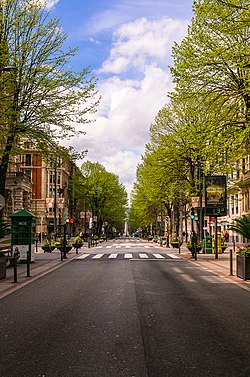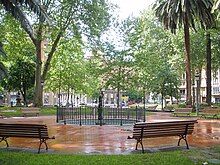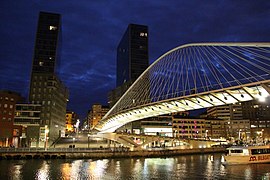
Bilbao is a city in northern Spain, the largest city in the province of Biscay and in the Basque Country as a whole. It is also the largest city proper in northern Spain. Bilbao is the tenth largest city in Spain, with a population of 345,141 as of 2015. The Bilbao metropolitan area has 1,037,847 inhabitants, making it one of the most populous metropolitan areas in northern Spain; with a population of 875,552 the comarca of Greater Bilbao is the fifth-largest urban area in Spain. Bilbao is also the main urban area in what is defined as the Greater Basque region.

Sabino Policarpo Arana Goiri, Sabin Polikarpo Arana Goiri, or Arana ta Goiri'taŕ Sabin (self-styled), was a Basque writer and founder of the Basque Nationalist Party (PNV). Arana is considered the father of Basque nationalism.

The Bilbao metro is a rapid transit system serving the city of Bilbao and the region of Greater Bilbao. Lines 1 and 2 have a "Y" shape, as they transit both banks of the river Ibaizabal and then combine to form one line that ends in the south of Bilbao. Line 3 has a "V" shape connecting the municipality of Etxebarri with the Bilbao neighbourhood of Matiko; the apex of the "V" is Zazpikaleak/Casco Viejo station, where all three current lines meet. The metro is connected with the Bilbao tram, Bilboko Aldiriak, Euskotren Trena, Feve, Renfe long-distance trains and Bilbao's bus station. All three lines use metre gauge.

Deusto, also known as Deustu in Basque and formerly known as San Pedro de Deusto, is one of the eight districts of Bilbao, (Spain). It is located on the right side of the Bilbao estuary, in the northwestern part of the city and bordering the estuary itself on the south and the southern hillside of Mount Artxanda and Mount Bandera on the north. Deusto was originally an elizate and also a municipality until 1925 when it was completely annexed by Bilbao in order to expand the free land available to the city. Deusto is known as the university district of the city as it is home to the University of Deusto and the Faculty of Economics and Business of the University of the Basque Country.
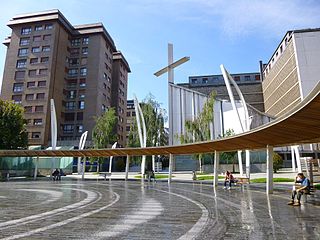
Indautxu is a quarter of central Bilbao, Basque Country (Spain), located in the district of Abando. It is a relatively affluent neighbourhood and is most famous for the large number of private hospitals and clinics, the large Society of Jesus school and the Doña Casilda Iturrizar park, all located in the area.

The Abando Indalecio Prieto railway station, usually known simply as Bilbao-Abando and previously known as Estación del Norte is a terminal railway station in Bilbao, Basque Country (Spain). The name comes from Abando, the district in which the station is located, and Indalecio Prieto, who was Minister of Public Works during the Second Spanish Republic. The station serves as the terminus station for several long and medium distance services operated by Renfe as well as commuter rail services within the Bilbao metropolitan area operated by Cercanías. The station has direct access to Metro Bilbao and to the tram, as well as many local and regional bus lines. The railway station Bilbao-Concordia, operated by Renfe Feve is located in close proximity. After the construction of the high-speed line Basque Y is finished, Bilbao-Abando will serve as the western terminus, which will involve the creation of a completely new station replacing the current one.

The Iberdrola Tower is an office skyscraper in Bilbao, Spain. Its construction started on 19 March 2009 and was officially inaugurated by King Juan Carlos I on 21 February 2012. The tower has a height of 165 metres (541 feet) tall and has 40 floors. The first eight floors of the tower were to hold a hotel by the Spanish hotel chain ABBA, but the project was eventually cancelled. The hotel will be replaced by an auditorium with the capacity of 200 people. The remaining floors have an office usage. The tower, built as Iberdrola's headquarters, is the tallest building in the Basque Country and the city of Bilbao, and the eighth tallest building in Spain.

The Gran Vía de Don Diego López de Haro is the main avenue of the city of Bilbao, Basque Country (Spain).

Basurto-Zorroza is the eighth district of the city of Bilbao (Biscay), in the Spanish Basque Country. It is divided into the neighbourhoods of Altamira, Basurto, Olabeaga, Masustegui-Monte Caramelo and Zorrotza. It is separated from Barakaldo by the river Kadagua. Its area is 7.09 square kilometers and has a population of 31,672 inhabitants.

The Lordship of Biscay was a region under feudal rule in the region of Biscay in the Iberian Peninsula between c.1040 and 1876, ruled by a political figure known as the Lord of Biscay. One of the Basque señoríos, it was a territory with its own political organization, with its own naval ensign, consulate in Bruges and customs offices in Balmaseda and Urduña, from the 11th Century until 1876, when the Juntas Generales were abolished. Since 1379, when John I of Castile became the Lord of Biscay, the lordship was integrated into the Crown of Castile, and eventually the Kingdom of Spain.

Bilbao-Atxuri is a former terminal railway station in Bilbao, Basque Country (Spain). It served as the terminus station for the commuter rail trains of Euskotren Trena lines to Durango, Bermeo, Eibar and Donostia for over one hundred years.

Zazpikaleak/Casco Viejo is a railway station in Bilbao, Basque Country, Spain. It is located in the historical neighborhood of Casco Viejo, in the district of Ibaiondo. It links the Bilbao metro rapid transit services with the Euskotren Trena commuter rail network. It is the main railway hub for trips between the metropolitan underground network and the railway services to Eibar, Gernika, Bermeo and San Sebastián as well as the Txorierri valley. The original metro station opened on 11 November 1995, and on 8 April 2017 in its current form.

Moyua is a station on lines 1 and 2 of the Bilbao metro. The station is located in the neighborhood of Abando, in the district with the same name. The station is located under the Moyua Plaza, named after Federico Moyúa, mayor of Bilbao during the early 20th century. It opened on 11 November 1995.
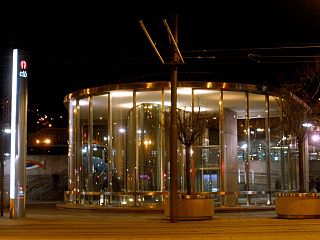
San Mamés is a transfer station in Bilbao, Basque Country, Spain. It is located in the neighbourhood of Basurto, part of the Basurto-Zorroza district of Bilbao. The station connects the rapid transit network of Bilbao metro with the Cercanías Bilbao commuter rail services, as well as with the Bilbao tram. It is also directly connected to Bilbao Intermodal, the city's main bus station. The station is also located in close proximity to San Mamés Stadium, home of the Athletic Club Bilbao. Since 2017, the metro station has been known as Santimami/San Mamés.

The Bilbao tram is a tram system in Bilbao, Basque Country, Spain. Operated by Euskotren under the brand Euskotren Tranbia, it comprises a single 7.8 km (4.8 mi) line, inaugurated on 18 December 2002 and last extended on 25 March 2022.

The Bilbao Metropolitan Area is the metropolitan area or continuous urban area based around the city of Bilbao, in the Basque Country, Spain. It comprises the city of Bilbao, the 25 municipalities that make the comarca of Greater Bilbao plus ten other surrounding municipalities, all of them in the province of Biscay.

Sabin Etxea is the official headquarters of the Basque Nationalist Party, located in Abando, Bilbao.

Abandoibarra is an area of the city of Bilbao, Spain, located next to the estuary in the neighborhood of Abando. After the process of deindustrialization experienced by the town since the mid-1990s, Abandoibarra became the central axis of urban regeneration in the city, continuing today in Zorrotzaurre.

The Bilbao-Concordia railway station, also known as La Concordia Station, and formerly and colloqually known as Santander Station, is a terminal railway station in Bilbao, Basque Country (Spain). The station was opened in 1902 and currently serves as the terminus station for several narrow-gauge regional and metropolitan railway services operated by Renfe Feve, a division of the state-owned Spanish railway company Renfe. The Bilbao-Abando railway station, also operated by Renfe and that offers medium and long distance services is located in close proximity.

Abando is a station on lines 1 and 2 of the Bilbao metro. The station is located in the neighborhood of Abando, in the district with the same name. The station is located close to Bilbao-Abando railway station, to which it is directly connected. It opened on 11 November 1995. It is one of the busiest stations in the network.
